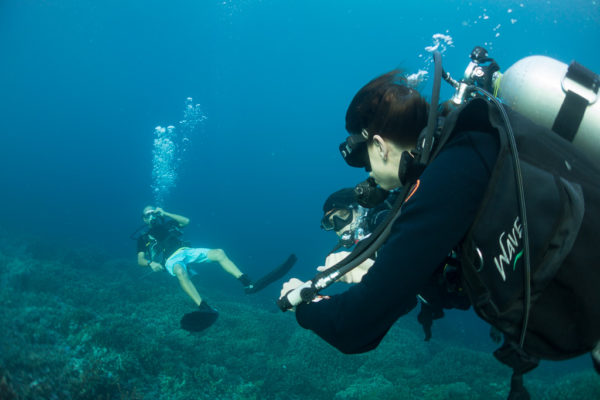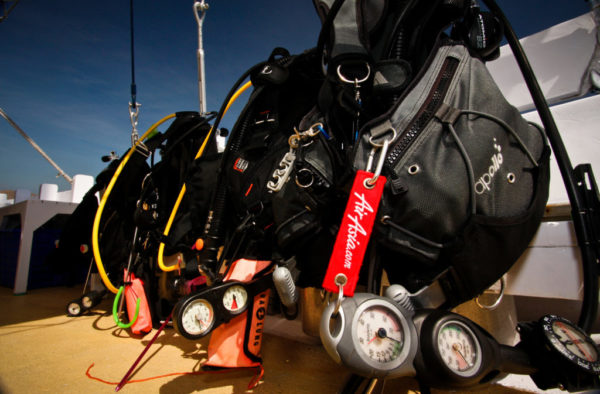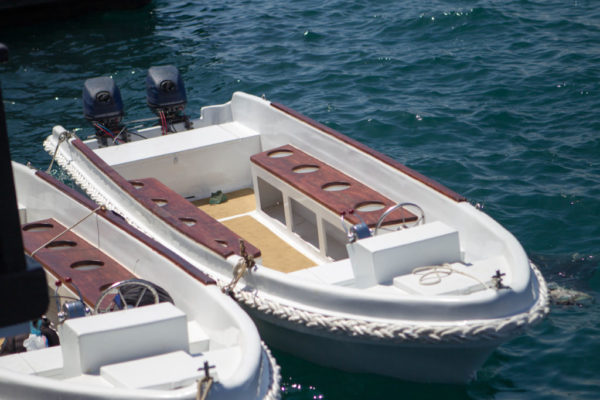Diving
 DIVE CONDITIONS
DIVE CONDITIONS
WATER TEMPERATURE
Komodo and Alor and Raja Ampat temperatures can vary between 20 C and 28 C, sometimes even cooler on the southern sites. A full wetsuit is recommended, also good for preventing coral scrapes with a 3mm or 5mm.
VISIBILITY
Typically between 10 to 50 metres, depending on season. Better visibility is generally encountered on the northern coastal sites although the southern sites can turn clear blue during December and January.
CURRENTS
Famous for it’s strong tidal currents, Komodo offers some stunning drift dives. Not all areas are affected however, and particular attention is placed on picking suitable sites and times to dive to guarantee optimum conditions.
Dive Equipment
Guests are encouraged to carry an SMB (surface marker buoy), Mini Strobe and a Dive Alert on EVERY DIVE. We have all of this equipment for rental and purchase, however we recommend you have your own before the start of your cruise. Guests will be shown how to fit and use this equipment correctly during the dive procedures briefing at the beginning of your cruise.
Oxygen Units & First Aid
Qualified guests will be shown the location of the Ombak Biru’s First Aid Kit and the O2 units. If there are guests on board who have training in either First Aid and/or O2 administration they are encouraged to identify themselves and to act accordingly in the event of an emergency and there are no dive crew immediately available.
Emergency Evacuation
Please be aware you will sometimes be diving in some very remote locations. The nearest working recompression chambers to the Ombak Biru’s normal operating areas are in Labuan Bajo, Denpasar, Bali and at the public hospital and in Mataram, Lombok. For Raja Ampat, he nearest recompression chamber is at Waist which is a distance away.To reach either will require the use of emergency air evacuation, which is not always available. With this in mind, please plan and execute your dives safely and carefully. We HIGHLY ENCOURAGE a travel and dive insurance to cover th unexpected. 
Things To Bring
Diving in Komodo is sometimes subject to wild temperature fluctuations. While most of the time a 3mm wetsuit is fine for the 30 degrees Celsius water temperature this can drop by 10 degrees over a short period of time. We think that a 5mm suit is a better all round choice.
A good pair of walking shoes is also a good idea, particularly for the Komodo cruises. We try to get on land as much as possible but some of our hikes are strenuous and cover rocky terrain.
Dive Courses
Diving in Komodo is enough to keep anyone busy but some people like to take advantage of the Ombak Biru’s scuba courses and continuing education programmes in a real life diving environment.
Due to the nature of our liveaboard operation most of the courses taught are specialities, particularly nitrox, but we can teach a whole range from PADI entry level programmes right the way up to professional level divemaster courses. Pre booking for any courses taught on board is appreciated.
Specialities include:
Nitrox – Advanced Nitrox – Deep – Night – Wreck – Drift – Photography – Videography – Equipment Specialist – Marine Life Awareness and Identification.
Dive Operations
EQUIPMENT
 If you don’t feel like carrying all of your own diving equipment around the world or don’t actually own any at all, don’t worry, the Ombak Biru is equipped with top quality rental equipment.
If you don’t feel like carrying all of your own diving equipment around the world or don’t actually own any at all, don’t worry, the Ombak Biru is equipped with top quality rental equipment.
The Ombak Biru is a preferred user of Aqualung and Mares dive equipment and we have a range of regulators, BCD’s, wetsuits, computers, fins and masks for our guests use, for rental or in an emergency.
If you need something special for a trip and don’t already have it, just drop us an e-mail and we will find it for you.
The Ombak Biru recommended diver safety equipment is available too is you don’t own your own: SMB (safety sausage), surface air horn (dive alert) and strobes.
NITROX
The Ombak Biru was the first vessel in the region to offer nitrox and runs a Nitrox Technologies membrane system to produce our diving gas. This is the latest, safest and most accurate method of production. We have several separate O2 analysers on board to enable our divers to analyse and log their own cylinder mix with every new fill.
The NT system differs from other production methods in that we subtract nitrogen from the mix rather than adding oxygen, hence minus the need for heavy O2 cylinders on board. Production limit is 40% for SCUBA or rebreather use.
TENDERS
Our two twin tenders were made in Bali by Bali Fibreglass, close to our home port of Benoa to our own design.  They are 6 metres long and 2.5 metres wide and are each powered by two 40 hp Yamaha outboards. Driven from the front to leave most of the interior free for divers and camera equipment, each craft is equipped with a VHF radio, shot line, stern line, dry area and easy to use boarding ladder. They are each crewed by at least one Divemaster as well as a driver and an assistant.
They are 6 metres long and 2.5 metres wide and are each powered by two 40 hp Yamaha outboards. Driven from the front to leave most of the interior free for divers and camera equipment, each craft is equipped with a VHF radio, shot line, stern line, dry area and easy to use boarding ladder. They are each crewed by at least one Divemaster as well as a driver and an assistant.
Personal scuba units are secured in special slots in the seats. This enables us to refill your cylinders in position so there is no need to carry heavy equipment up and down the tender entry staircase.
BRIEFING AND DIVE CREW
At some time during the first day of your cruise our dive staff will introduce themselves and give an involved vessel orientation and safety briefing as well as a diving and photo procedures outline to acquaint you with the Ombak Biru and how we work.
Before every dive a detailed briefing is given regarding the specific site to be visited to give you an idea of what to expect in the way of currents, depth, visibility, water temperature and underwater geography/architecture.
Briefings are always backed up with maps of the area or site and heads up of what marine life we expect to encounter on the dive with photo/video recommendations. There are plenty of identification books on board too to confirm special sightings

